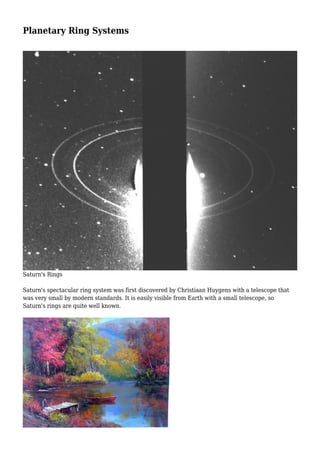
Planetary Ring Systems: A Feature of the Gas Giants
- 1. Planetary Ring Systems Saturn's Rings Saturn's spectacular ring system was first discovered by Christiaan Huygens with a telescope that was very small by modern standards. It is easily visible from Earth with a small telescope, so Saturn's rings are quite well known.
- 2. It is less well known that the other Jovian planets also have ring systems. They are not easily visible and were not discovered until relatively recently. Rings of Uranus The rings of Uranus were discovered unexpectedly on March 10, 1977 by a group of astronomers led by James Elliot. These astronomers were studying an occultation of the star, SAO 158687, by Uranus. In an occultation, the planet passes in front of the star. Studying the starlight after it passed through the atmosphere of Uranus would tell the astronomers something about the planet's atmosphere. However something unexpected happened. The star's brightness dimmed nine times before the occultation and, in a symmetrical pattern, nine times after the occultation. Astronomers interpreted these data as a system of nine rings orbiting Uranus. Fewer brightness decreases or the lack of a symmetrical pattern would have suggested previously undiscovered moons. The symmetry of the pattern however forced astronomers to conclude that Uranus has rings. When the Voyager mission flew by Uranus in 1986, photos confirmed that Uranus has a faint ring system. The rings are much narrower and darker than Saturn's rings. Voyager photos revealed shepherd moons confining the narrow rings around Uranus. The darkness of the rings suggests the individual ring particles are not icy like in Saturn's rings. Jupiter's Ring Mario Acuna and Norman Ness suggested, on the basis of indirect data from the 1974 Pioneer 11 flyby of Jupiter, that Jupiter might have a ring. At the time few astronomers took the suggestion seriously. When the Voyager mission flew past Jupiter in 1979 however it directly photographed the ring around Jupiter. Unlike Saturn's easily visible ring system, Jupiter's ring is faint and not visible from Earth. The individual particles in Jupiter's ring are much smaller than those in Saturn's rings. Many are perhaps only a few millionths of a meter in diameter. Particles this small would not last very long. So, either Jupiter's ring is, in astronomical terms, short-lived or the ring particles are replenished somehow. Rings of Neptune
- 3. By 1979 astronomers knew that Saturn, Uranus, and Jupiter all had rings. So they asked if Neptune also had rings. They had to wait a decade until the Voyager spacecraft reached Neptune to find the answer. Several astronomers tried to observe occultations of stars by Neptune to see if they could discover rings like they were discovered around Uranus. These experiments produced conflicting results. Some astronomers observed brightness decreases like those for Uranus. Others found no evidence for rings. What was going on? When the Voyager mission finally reached Neptune in 1989, photographs revealed five very thin narrow rings. Two of the rings originally appeared as one ring. More interestingly however Neptune's rings are clumpy. Some portions of a ring are thicker that other portions. The clumps explain why the occultation experiments produced conflicting results. The experiments could detect the thicker portions of the rings but not the thinner portions. Saturn's rings are the most spectacular, but ring systems are a feature of all the gas giant planets in the solar system. Further Reading Chaisson, E, and McMillan, S. Astronomy Today 5th ed., Pearson, 2005. Beatty, J.K., O'Leary, B., and Chaikin, A. The New Solar System 2nd ed., Cambridge, 1982. https://suite.io/paul-a-heckert/m372dj